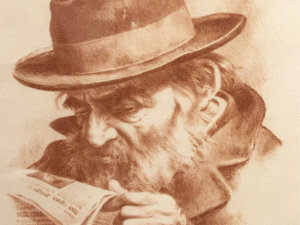The other day, I boarded a bus in my neighborhood and went through the usual motions of paying for the trip. I produced my trusty “Rav Kav,” the plastic card with a computerized chip that has become the key to navigating the Israeli public transportation system, and placed it on the scanner mounted next to the driver’s seat. The screen revealed that the card was empty, and I rummaged in my wallet for cash, asking the driver to load a new kartisiyah – a pass for ten bus rides sold at a discounted price – onto the card.
“Zeh lo kartisiyah,” the driver said with a wave of his hand, as if he could somehow make my years of experience riding Israeli buses vanish into thin air. “Zeh erech tzavur.”
I had no idea what an erech tzavur (literally translated as “accumulated value”) was supposed to be, but I understood immediately that the much-touted reforms in the pricing of public transportation had taken effect. The driver pressed his touch-screen several times and showed me the options. “Choose an amount to pay – minimum thirty shekels – and then you can use it on the buses of any company,” he explained. The fare for a single ride, I saw, was 3.70, but discounts were applied at the moment of purchase. If I chose to pay 30 shekels now, my card would reflect a credit of 37.50 shekels, which could be used to pay for ten bus rides, with half a shekel left over at the end. Steeper discounts would apply if I chose any of the higher “accumulated values” being offered. I chose the 30-shekel option and took my seat, marveling at the fact that, ostensibly, the public transportation authority had devised an entirely new payment system in order to lower the cost of transportation, rather than simply reducing the prices.
I still remember when the Rav Kav was first introduced, raising the complexity level of taking a bus by several notches. In the old days, passengers boarding a bus could purchase a single ticket or a paper kartisiyah good for five or ten trips, or they could show the driver a monthly pass (also purchased on the bus at the beginning of each month). Round-trip tickets were also available for purchase on some routes. The various bus passes were available at special discounts for minors or senior citizens as well, and every bus driver was equipped with his own hole puncher, which he would use to perforate the marked squares in each ticket for every passenger in a group. I always wondered how the drivers managed to accept money, count out change, punch tickets, and handle the steering wheel at the same time, but other than that, the system seemed to work fine.
Apparently, though, someone decided that the digital age needed to come to the country’s buses as well.
It began with the advertisements urging everyone to take advantage of the latest technological development by having a personalized Rav Kav issued. We made our way to the temporary offices, where average citizens waited in line to be photographed and receive a brand new card bearing a magnetic stripe along with their name and picture. Children’s cards were automatically programmed to provide the discounts owed to them.
Slowly but surely, the paper kartisiyot and bus passes were phased out. Finally, the day came when bus drivers no longer accepted these old-fashioned tickets.
The Rav Kav had a major advantage, of course, one that was heavily advertised: If you lost a personalized Rav Kav, you could recover the balance on the card and have it programmed into a replacement. Somewhere, a powerful server was monitoring the use of every single Rav Kav and recording every transaction. But as we soon discovered, even capitalizing on this benefit was no simple matter.
Unlike in the old days, when a new kartisiyah could be purchased on any bus, we could obtain replacement Rav Kavs only by visiting the stores authorized to sell them – of which there were exactly two in the entire city where I lived. (That’s twice as many as the number in the city where I live now!) There was a 10-shekel fee for a replacement card, and then it took a couple of business days for the balance of the lost card to be transferred to the new one. If you had purchased a monthly pass before losing your card, you could spend days having to pay the full fare for every trip on a bus before the pass was restored – even if you had the opportunity immediately after losing your card to visit the store where Rav Kav cards were sold.
Of course, the more technologically advanced the payment system, the more potential exists for glitches. There were plenty of tales of Rav Kav cards that mysteriously failed to work or to reflect a balance that had been loaded onto them. And there was the time when my own Rav Kav card began displaying signs of cantankerousness at a young age. Every time I boarded a bus, the card stubbornly refused to communicate with the digital reader. Each time, the driver would rub the card against his shirt, bend it backward and forward, and press it against the reader with his full strength until the welcome sound of a beep was finally heard, signaling that the machine had succeeded in reading it. “Why don’t you just get a new card already?” many of them demanded in frustration.
Well, I finally gave in and made my way to the Rav Kav store. “Ten shekels,” the clerk said impassively when I requested a replacement card.
“Ten shekels for what?” I asked in surprise. “I didn’t lose my card. I wasn’t even careless with it. It simply wore out.”
“I’m not authorized to give you a new card without collecting the fee,” she replied. “If you want, you can call the bus company and ask them to give you a free card.”
I did call, and the company representative informed me laconically that I would probably have to pay the fee. “You can send the card to us and we’ll check to see if it was damaged in a way that we feel we should take responsibility for,” he added, “but in all likelihood, you will have to pay for it.”
“How do I send it to you?” I asked.
“Give it to any bus driver. We’ll get back to you in a few days….”
I paid the ten-shekel fee and handed the unusable card to the next bus driver I encountered. Of course, nothing ever came of that.
What bewildered me the most, of course, was that the Rav Kav cards were not programmed merely to accept a sum of money and then deduct the bus fare from the balance. The system was far more complicated than that. Every bus company still sold its own kartisiyot and monthly passes. The only difference was that they could now be purchased only by the bearer of a Rav Kav. Discounts for minors, senior citizens, and other entitled individuals were also only available via their personalized Rav Kav cards. Essentially, the pricing system hadn’t changed at all. We simply had the added encumbrance now of having to use our Rav Kav cards in order to take advantage of the discounts for tickets for multiple trips.
Compounding the absurdity was the fact that an error, once it was made, could not be reversed. I once paid for a kartisiyah on a bus and watched as the driver struggled to load the ticket onto my card. A minute or two after I took my seat, the driver called me back to the front and asked to see the card again. He punched a few buttons on his digital reader, scanned the card, and then read a printout that emerged from the machine (all the while navigating the twists and turns of the road, of course). Finally, he said, “I accidentally loaded two kartisiyot on your card. You’ll have to pay double.”
“Can’t you just reverse one of the purchases?” I asked. “Or maybe you can charge my card for another ten trips to cancel out the extra ticket.”
The driver shook his head. “The computer records every transaction I make during the day, and I can’t reverse anything,” he told me. “If it shows that I sold you an extra kartisiyah, I’m going to have to pay for it out of my own pocket. If you want,” he added, “you can wait until you start using it and then pay me the next time you take my bus.”
Who could guarantee that I would ever see that driver again? Not wanting either of us to have the headache of having to remember the extra ticket, I paid him on the spot. Ironically, for the next few months, I found myself encountering that driver regularly; each time, he greeted me with a warm smile.
At least I had made a friend.
In light of my experiences, I can understand how the switch from kartisiyot to the concept of erech tzavur would be a welcome change. At the same time, it seems that the new system is also not immune to the complexities and vagaries that seem to have plagued the public transportation system since the Rav Kav’s inception. Just yesterday, I boarded another bus along with my six-year-old daughter. I had forgotten to bring her Rav Kav with us, so I decided to pay for both of us with mine; at least I could benefit from the discounted price that is available to Rav Kav users. I had used a single Rav Kav for more than one person many times in the past, and I naively assumed that it would not be problematic. “Charge this card for two,” I said to the driver as I slipped it into the scanner.
The driver and I were both equally surprised when the machine refused to accommodate me. After one fare was paid, he attempted to charge the card a second time but was rebuffed by a message flashing on the screen: “Group travel not possible with this profile.” He handed the card back to me with a shrug. “Just pay next time,” he suggested.
Is this the new rule? No Rav Kav can be used to pay for a second passenger? I could not help but envision the typical large chareidi family boarding a bus. Anyone who lives in Israel has certainly witnessed such a scene: an adult or two clambering aboard the vehicle, struggling to find a place for a stroller while a gaggle of children excitedly climb into seats. In general, the family selects a representative – either one of the parents or an older child – to head to the front of the bus and pay the fare, clinging to a pole to maintain their footing while paying with an adult Rav Kav, then a child’s Rav Kav, and giving the driver detailed instructions on how many fares to deduct from each. The mechanical sounds of the electronic reader processing each card and then producing receipts mingle with the rumbling of the bus’s engine and the babble of voices from the children. Having taken my own family on buses on numerous occasions, I can attest to the fact that the experience is often quite overwhelming. And now, I imagine the same family boarding a bus while the designated payer fumbles with a separate Rav Kav for each family member. By the time all the fares have been paid, the family will likely have arrived at their destination. One can only imagine the other passengers waiting with ill-concealed irritation for the flurry of payments to end.
“Do you know who makes up the rules for public transportation?” a friend commented to me today. “People who have their own cars and have never had to take a bus in their lives! They have no idea what type of burdens they are placing on the average bus or train passenger! What difference does it make to them if someone pays on the same card for more than one passenger?”
In truth, my experience may have been a fluke. I have attempted to research the issue, and I have yet to find a definitive statement in any of the recently issued guidelines on whether a single Rav Kav can be used for more than one person at a time. I do find it difficult to understand why the workings of the Rav Kav have been so convoluted throughout the past few years. But I can only hope that the new reforms – if indeed that is the correct term – are a step in the right direction.








